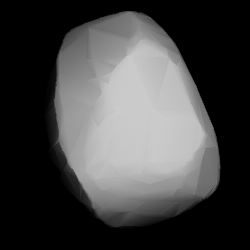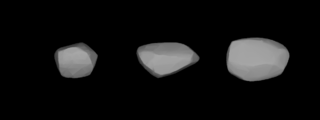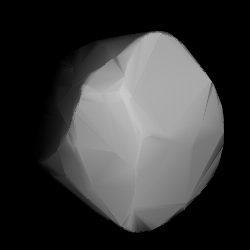
164 Eva is a main-belt asteroid that was discovered by the French brothers Paul Henry and Prosper Henry on July 12, 1876, in Paris. The reason the name Eva was chosen remains unknown, though Karl Ludwig Littrow suspected a "worldly origin". The orbital elements for 164 Eva were published in 1877 by American astronomer Winslow Upton. It is categorized as a C-type asteroid and is probably composed of primitive carbonaceous chondritic materials.

193 Ambrosia is a main belt asteroid that was discovered by the Corsican-born French astronomer J. Coggia on February 28, 1879, and named after Ambrosia, the food of the gods in Greek mythology.

273 Atropos is a typical Main belt asteroid that was discovered by Austrian astronomer Johann Palisa on 8 March 1888 in Vienna.

314 Rosalia is a large Main belt asteroid. It was discovered by Auguste Charlois on 1 September 1891 in Nice.

365 Corduba is a very large main-belt asteroid that was discovered by the French astronomer Auguste Charlois on 21 March 1893 from Nice. It is classified as a C-type asteroid and is probably composed of carbonaceous material.
568 Cheruskia is a minor planet, specifically an asteroid orbiting in the asteroid belt that was discovered by German astronomer Paul Götz on 26 July 1905 from Heidelberg.

572 Rebekka is a minor planet orbiting the Sun, which was discovered on September 19, 1905, by a German astronomer Paul Götz in Heidelberg. It was named after a young lady from Heidelberg, and may have been inspired by the asteroid's provisional designation 1905 RB.
585 Bilkis is a minor planet, specifically an asteroid orbiting in the asteroid belt. It was discovered by German astronomer August Kopff in 1906 February and was given the Koran name for the Queen of Sheba. Photometric observations at the Palmer Divide Observatory in Colorado Springs, Colorado in 2006–7 were used to build a light curve for this object. The asteroid displayed a rotation period of 8.5742 ± 0.0005 hours and a brightness variation of 0.40 ± 0.02 in magnitude.

605 Juvisia is a minor planet, specifically an asteroid orbiting in the asteroid belt that was discovered 27 August 1906 in Heidelberg by German astronomer Max Wolf. It was named after the commune Juvisy-sur-Orge, France, where French astronomer Camille Flammarion had his observatory.
607 Jenny is a minor planet, specifically an asteroid orbiting in the asteroid belt that was discovered by German astronomer August Kopff on September 18, 1906.
620 Drakonia is a minor planet, specifically an asteroid orbiting in the asteroid belt. It was discovered October 26, 1906, in Taunton, Massachusetts, by American astronomer Joel Hastings Metcalf and given the preliminary designation 1906 WE. It may have been named for Drake University.
630 Euphemia is a mid-sized Eunomian asteroid.
687 Tinette is a minor planet, specifically an asteroid orbiting primarily in the asteroid belt. It was discovered by Austrian astronomer Johann Palisa on 16 August 1909 from Vienna and was given the preliminary designation 1909 HG.

708 Raphaela is a minor planet orbiting the Sun.

747 Winchester is an asteroid, a minor planet orbiting the Sun. It was discovered in 1913, and is named after the town in which it was discovered, Winchester, Massachusetts, in the USA.
756 Lilliana is a minor planet orbiting the Sun that was discovered by American astronomer Joel Hastings Metcalf on 26 April 1908 from Taunton, Massachusetts. It rotates around its axis of rotation every 9.36 hours.
860 Ursina is a minor planet orbiting the Sun that was discovered in 1917 by German astronomer Max Wolf. The origin of the name is unknown.
880 Herba is a minor planet orbiting the Sun that was discovered by German astronomer Max Wolf on 22 July 1917 in Heidelberg.
947 Monterosa is a minor planet orbiting the Sun.
999 Zachia is a main-belt asteroid that was discovered by German astronomer Karl W. Reinmuth in 1923 and named after Hungarian astronomer Franz Xaver von Zach.









